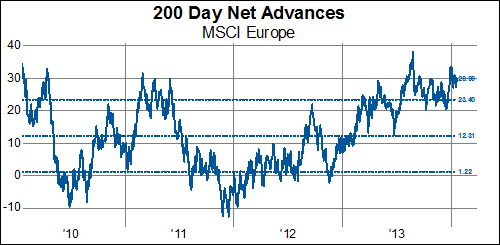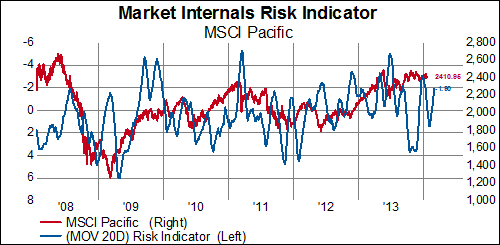We've noted on several occasions over the past few weeks the fact that trader positioning and sentiment towards the yen is pushing the most extreme negative levels in a decade. The chart below demonstrates that large speculators (blue line, the folks who are usually wrong at major turning points) have the largest net short position since 2007 while the commercials (green line, the "smart money") have the largest net long position since 2007.

What we'd like to focus on in this post, however, is the fundamental backdrop that suggests the potential for significant upside in the yen should the current calm in financial markets turn into something a bit more interesting and create 1) deflationary fears and/or 2) a bid for safety.
The first data we'll look at is the already announced monetary policies of each central bank and what that implies for the relative size of the Fed and BOJ balance sheets and thus value of the the JPY/USD. In the table below we show the likely 2014 asset purchases of the Fed and BOJ in trillions of USD based on an exchange rate of 100 JPY/USD. It is clear that the BOJ will be far more aggressive than the Fed in its 2014 purchases as the BOJ will increase it's balance sheet by 11% of GDP while Fed will only increase its balance sheet by 2.7% of GDP.

This much has been the focus of countless news articles and research pieces. What has been somewhat under analyzed is the projected value of the yen based on the relative size of the two central bank balance sheets. In the chart below we plot the ratio of total assets of the BOJ in USD terms relative to total assets of the Fed and then overlay the JPY/USD exchange rate (dark blue line, right axis). For 2014 we have created a range of this ratio. The low estimate (red line) is based on previously announced policies and assumes the Fed tapers its purchases by $10bn per meeting throughout 2014. The high estimate (light blue line) assumes the BOJ will
double it's already planned 2014 purchases from
¥70tn to ¥140tn and that the Fed will continue to taper by $10bn per meeting. What we find is that not only has the taper been fully discounted, but the market is now discounting a doubling down of bond purchases by the BOJ in 2014. This may come to pass if as seems probable Japan finds itself in recession in the second half of this year thanks to the country's own fiscal cliff (the consumption tax hike in April combined with fiscal stimulus turning into fiscal drag). We have our doubts about the operational feasibility of doubling asset purchases with a stagnant or improving budget deficit, but that is a conversation for another day.

Next, we'll focus on more market oriented data that suggests significant upside for the yen in the midst of any market turmoil. The first chart below shows the relationship between the US 10Y treasury yield and JPY/USD (red line, left axis). The current JPY/USD exchange rate is implying 10Y treasury yields north of 3.5% vs the current 2.85%. A 10 year treasury yield of 3.5% was last seen in 2011 and seems a universe away. In any case, the tight correlation in these two series implies that a bid in the treasury market will likely be accompanied by a rapidly rising yen relative to the dollar.

This next chart shows the differential in 2 year treasury bond yields in the US and Japan and compares it to the JPY/USD exchange rate (red line, right axis). All else equal, this chart suggests that the JPY/USD cross is discounting not only a fully carried out tapering, but an almost 2% increase in short rates in the US. Given Fed guidance we should expect any increase in interest rates until at least 2015, and even then only a minor increase.

The final data item we'll discuss is the current real effective exchange rate of the yen. The real effective exchange rate calculates the effective value of a currency relative to its trading partners while taking into account the impacts of inflation. In this case a lower number implies a weaker currency. The takeaway from the below is that Japan's real effective exchange rate has never been lower over the last 24 years. Based on the mean reverting nature of real effective exchange rates, we'd expect Japan's real effective exchange rate to be biased higher in the years to come.

Based on the above information and more, we are not convinced that a rapidly falling yen in 2014 is a given. On the contrary, we can even make a fundamental case as to why the yen is likely strengthen vs the dollar to somewhere in the mid 90s in the case of any bid for safety in the markets.


















































